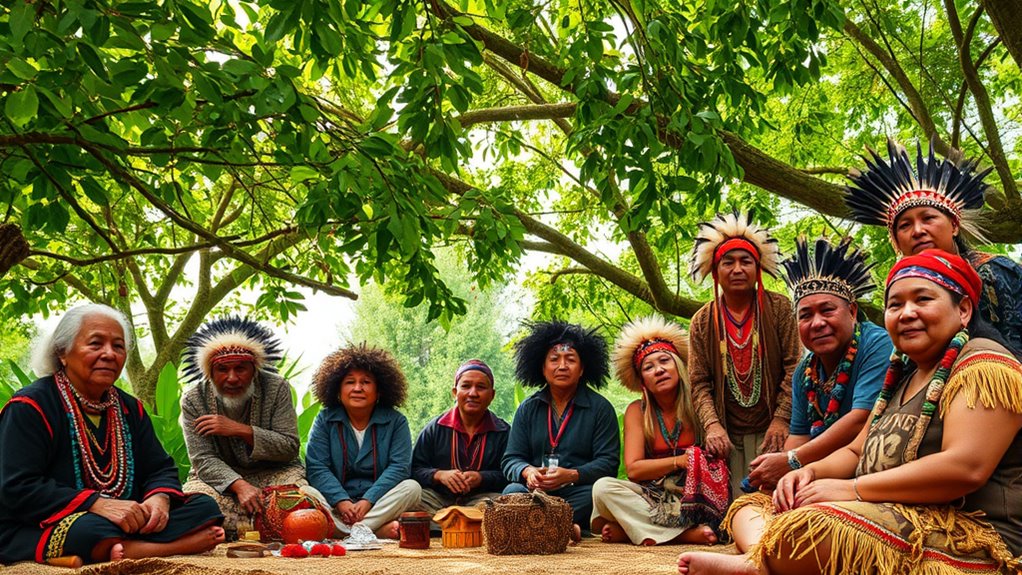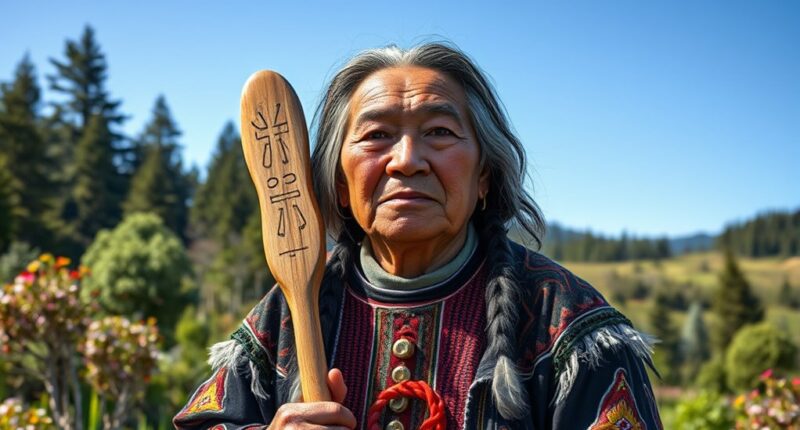Indigenous languages shape your understanding of culture and identity, serving as living links to history and traditions. They contain valuable knowledge about local ecosystems, medicines, and social customs that, if lost, take cultural perspectives and pride with them. Rekindling these languages helps communities reconnect and strengthens wellbeing, fostering a sense of belonging and resilience. By embracing indigenous languages, you support the preservation of rich human diversity and access deeper stories worth exploring further.
Key Takeaways
- Indigenous languages embody unique worldviews, cultural practices, and traditional knowledge essential to community identity and heritage.
- Preserving these languages maintains cultural pride, resilience, and strengthens social cohesion within Indigenous communities.
- Language loss results in the disappearance of oral histories, customs, and ecological knowledge vital for cultural continuity.
- Revitalizing Indigenous languages supports mental health, self-esteem, and a sense of belonging among speakers.
- Protecting linguistic diversity safeguards human cultural richness and promotes respect and understanding across cultures.

Have you ever considered how indigenous languages shape our understanding of culture and identity? These languages are far more than just a means of communication; they are the living threads that connect communities to their history, traditions, and worldview. When an indigenous language begins to fade, it’s not just words that are lost, but a unique perspective on life, relationships, and the environment. That’s why language revitalization efforts are so essential—they serve as a bridge to reclaim and reinvigorate cultural heritage that might otherwise disappear. By supporting these initiatives, you help guarantee that future generations can access the wisdom and stories embedded in their native tongue, strengthening their sense of belonging and identity. Preserving linguistic diversity is vital for maintaining the richness of human cultural expression.
Indigenous languages connect communities to their history, culture, and worldview—preserving them safeguards identity and collective wisdom.
Cultural preservation is at the heart of maintaining indigenous languages. Every language contains a wealth of knowledge about local ecosystems, medicinal plants, traditional practices, and social customs. When communities work to keep their languages alive, they’re also safeguarding their cultural practices, ceremonies, and oral histories. This preservation fosters pride and resilience, especially in the face of historical marginalization and systemic efforts to suppress indigenous identities. You can play a part in this process by advocating for policies that protect linguistic rights, participating in language learning programs, or simply respecting the linguistic choices of indigenous people. Each action contributes to a broader movement that recognizes language as a fundamental pillar of cultural integrity.
Furthermore, indigenous languages are deeply tied to individual and collective wellbeing. When people speak their native tongue, they often experience a stronger connection to their roots and community. This connection can boost mental health, self-esteem, and a sense of purpose. Conversely, the loss of a language can lead to feelings of disconnection and cultural alienation. Supporting language revitalization initiatives helps restore this sense of identity and belonging, which is essential for emotional and social wellbeing. It also promotes intercultural understanding, fostering respect and appreciation for diverse ways of seeing the world. As you become involved in efforts to preserve and promote indigenous languages, you’re contributing to a broader movement that values human diversity, resilience, and the importance of cultural continuity.
In essence, indigenous languages matter because they embody the histories, knowledge, and identities of their communities. By championing language revitalization and cultural preservation, you help uphold the dignity and richness of indigenous peoples’ heritages. This isn’t just about saving words—it’s about safeguarding the stories, wisdom, and identities that shape us all. Your support can make a real difference in ensuring that these languages, and the cultures they carry, continue to thrive for generations to come.
Frequently Asked Questions
How Do Indigenous Languages Influence Modern Education Systems?
You see, indigenous languages influence modern education systems through language revitalization efforts and curriculum integration. When you incorporate these languages into classrooms, you help preserve cultural heritage and promote inclusivity. This approach not only enriches students’ learning experiences but also empowers Indigenous communities. By supporting language revitalization and integrating Indigenous languages into curricula, you foster respect, understanding, and a stronger connection to cultural identity within modern education.
What Role Do Indigenous Languages Play in Environmental Stewardship?
You play a crucial role in environmental stewardship through indigenous languages by fostering cultural transmission and preserving traditional knowledge. When you speak and teach these languages, you help pass down essential insights about local ecosystems, sustainable practices, and natural resources. This traditional knowledge guides responsible land management and conservation efforts, ensuring the environment remains healthy for future generations. Your efforts support the protection and celebration of indigenous ways of understanding and caring for the Earth.
How Can Technology Support Indigenous Language Preservation?
You can harness technology to support indigenous language preservation by engaging in digital archiving and participating in language revitalization programs. Digital archiving preserves precious words and stories, ensuring they’re not lost to time. Language revitalization programs use apps and online platforms to teach and practice languages, making them accessible and vibrant. By embracing these tools, you help safeguard your heritage and keep your language alive for future generations.
In What Ways Do Indigenous Languages Impact Mental Health?
You see, indigenous languages boost mental health by fostering a sense of belonging and identity through language revitalization. When you engage with your native tongue, you strengthen community resilience, which supports emotional wellbeing. This connection helps reduce feelings of isolation and promotes pride in your culture. By preserving and sharing your language, you actively contribute to mental wellness and create a stronger, more resilient community for future generations.
How Do Indigenous Languages Shape Intergenerational Relationships?
Imagine a grandmother teaching her grandchildren Indigenous songs in her native language, strengthening family bonds and cultural continuity. You see, Indigenous languages shape intergenerational relationships by passing down stories, traditions, and values. When elders share their language, it creates a deep connection across generations, fostering a sense of belonging. This ongoing exchange helps keep cultural practices alive and nurtures respect and understanding within families, ensuring the legacy continues.
Conclusion
Just as the phoenix rises from its ashes, preserving your indigenous language fuels your community’s resilience and identity. By embracing and safeguarding your language, you keep the stories, traditions, and wisdom alive for future generations. Remember, every word you protect strengthens the fabric of your culture. Don’t let your voice fade into silence—because, like the eternal flame of Prometheus, your language lights the path toward a richer, more vibrant future.
Mary is a passionate writer who brings creativity and a fresh perspective to our team. Her words have the power to captivate and inspire, making her an essential contributor to our content. Mary’s commitment to storytelling and dedication to promoting Indigenous culture ensures that her work touches the hearts of our readers. We’re fortunate to have her as part of our team.










